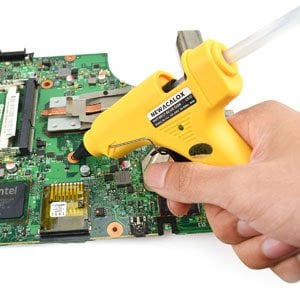Can I Glue to Parylene?
Posted by Sean Horn
Friday, July 27, 2018 7:30
@ 7:30 AM
With reliable moisture barrier properties, parylene (XY) conformal coatings generally have a hydrophobic surface when deposited onto substrates, causing liquids to form separate droplets on film surfaces. While this outcome is useful for many XY applications, greater hydrophilic response, wherein XY molecules form ionic or hydrogen bonds with water molecules, can also be desired. This can be achieved by applying glue or epoxy on top the deposited parylene; surfaces acquire enhanced hydrophilic properties, becoming more wettable.
Enhanced Surface Hydrophilicity and Other Issues
Application of glue to parylene film surfaces will often add to its surface hydrophilicity. These procedures have value for biomedical purposes, including use with implanted devices with Parylene C coatings. The technique of photoinduced phospholipid polymer grafting on XY coatings adds advanced lubrication and anti-biofouling properties to the film. In these cases, poly(2-methacryloyloxyethyl phosphorylcholine (MPC)) adhesives can be attached to XY coatings to enhance the surface’s lubrication and antibiofouling properties, limiting accumulation of microorganisms on the implanted device’s wetted surfaces. While these procedures have proven successful, care has to be taken to assure the consistency of the bond between the XY and the glue, which may be weakened if exposed to thermal cycling during operation.
Problems can also emerge from delamination and/or moisture ingress at the interface of the glue and parylene. Adhesion between glue/parylene may diminish under wet conditions consistent with biomedical implanted devices; lowered adhesion between parylene/substrate can develop as well, if barrier properties are further weakened. Oxygen plasma treatment is often cited as better-suited for enhanced surface hydrophilicity.
 Parylene itself can be used as a bonding agent for semiconductor wafers employed for integrated circuitry useful to printed circuit boards (PCBs) and related assemblies; crystalline silicon is typical wafer material. Bonds of parylene with itself, and to silicon, have been achieved, with:
Parylene itself can be used as a bonding agent for semiconductor wafers employed for integrated circuitry useful to printed circuit boards (PCBs) and related assemblies; crystalline silicon is typical wafer material. Bonds of parylene with itself, and to silicon, have been achieved, with:
- a maximum bonding strength of 2.38 megapascals (MPa),
- in a vacuum environment,
- after heating to 230°C, and
- applying sufficient bonding force.
However, dielectric bonding glues combining two polymers – such as benzocyclobutene (BCB) and polyarylene ether (PAE) (commercially known as Flare) – create better wafer bonds alone than when combined with parylene, limiting the utility of parylene/glue interface for these purposes. Moreover, this is a case of parylene being used as the bonding agent between two other substances (as a kind of glue), rather than glue being applied directly to parylene for specific purposes.
Masking Adhesives
Integral to surface preparation, the masking process protects assembly contacts and keep-out areas from the encapsulating effects of the parylene itself, which would suspend their operational capacities. Masking’s purpose is assuring selected assembly components are NOT covered by the applied parylene film, maintaining their performance functionality. Because XY’s:
- dielectric properties also disable assembly contacts,
- or can interfere with the required movement of components during operation,
- masking is necessary for these components to retain their capacity to accept an electrical charge and/or move as designed.
Masking materials must thoroughly shelter the keep-out regions, without gaps, crevices or similar surface breaches, to provide reliable connector function after coating. Among basic masking materials are masking dots, tapes and contact pads, which generally affix to the component surface with a peel-able adhesive. Masking dots are small stickers fastened over the contact before coating is initiated. Masking tapes/contact pads generally employ one-of-two formats: (1) liquid peel-able latex masking materials, similar to dots, or (2) polyester or Kapton tape. All adhesive-based masking materials prevent coating ingress into the component. After XY application, the masking is carefully peeled or otherwise removed, as soon as possible after the parylene has dried, to prevent tearing the film, while exposing the contacts or other masked regions.
Masking prior to XY application is another process interface where glued adhesives and parylene interact, but does not represent a process where glue is applied directly to XY’s surface. Gluing to parylene is possible, but less-used; surface interface is not entirely reliable, often leading to delamination and other functional problems.
To learn more about parylene and issues that can arise during processing, download our whitepaper now:
Download our guide on Parylene 101
Comments
Homepage 4/17/2020. 10:17:10 AM
... [Trackback] [...] Informations on that Topic: blog.paryleneconformalcoating.com/whats-the-difference-between-potting-and-conformal-coating/ [...]

londondrugscanada.bigcartel.comlondon-drugs 4/17/2020. 10:17:10 AM
cialis uk https://londondrugscanada.bigcartel.com/london-drugs This is nicely expressed. !